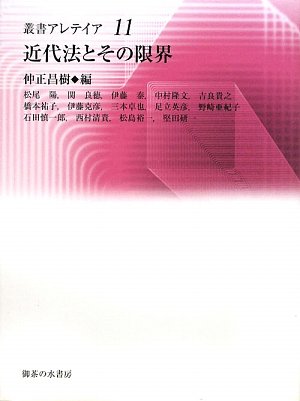19 0 0 0 ワイヤレス12誘導心電図伝送による院外心電図伝送の試み
- 著者
- 西川 豪 野々木 宏 森 典子 松尾 陽子 清水 史郎 小田 敏子 土井 修 神原 啓文
- 出版者
- 日本循環制御医学会
- 雑誌
- 循環制御 (ISSN:03891844)
- 巻号頁・発行日
- vol.33, no.2, pp.88-95, 2012
ワイヤレス12誘導心電図伝送「富士山(ふじやま)」を開発し,プレホスピタルから専門病院への伝送の有用性を検討するため実証実験を行った.<BR>方法:小型心電計からBluetooth方式でスマートフォンへ心電図データを送信,画像ファイルを伝送するシステムを用い心電図を走行車両から伝送,さらに各種施設から病院専門医へ伝送し,伝送前後の比較を行った.<BR>結果:伝送前後の心電図は変化なく,伝送時間も7~95秒(中央値23秒)で遅延はなかった.院外伝送24例では家電からのノイズ1例以外は質の高い伝送が得られた.ワイヤレス12誘導心電図は小型,軽量で様々な医療現場での活用が期待される.
2 0 0 0 OA アーキテクチャによる規制作用の性質とその意義
- 著者
- 松尾 陽
- 出版者
- 日本法哲学会
- 雑誌
- 法哲学年報 (ISSN:03872890)
- 巻号頁・発行日
- vol.2007, pp.241-250, 2008 (Released:2021-03-31)
In recent years, the state which heavily depends on the governmental regulations has been criticized and demands for “deregulation” are increasing. One of the central questions is “What is regulation?” In order to answer this question in ‘Post-Regulatory State’ debate we make clear how regulation by architecture (which was suggested by Lawrence Lessig) functions and show its significance. We analyze “New Chicago School” approach, into which the concept of architecture was introduced by Lessig, in order to understand necessity for thinking about regulation by architec ture in jurisprudence and recognize its importance for carrying out legal regulation effectively. This approach augues that there are multiple regulators (law, market, social norm, and architecture) , that each regulator interacts, and that law can efficiently control human behavior through its regulating other regulators (“indirect regulation”, for example, gatekeepers regulation). Because of these features, regulation by architecture is not only necessary but also important for thinking about legal regulation. Here we define the architecture as “controllable physical environment”. Regulation by architecture functions in the way that its constraint cannot be ignored, that it regulate the regulated whether he recognizes the architecture as a regulation or not, and that we don’t need any agent to enforce it. Unlike legal regulation, regulation by architecture functions without monitoring and enforcement because of these features. Because of this nature of regulatory functions in architecture, regulation by architecture can be very efficient, but reduce opportunities to rethink of validity of regulation at the stage of monitoring and enforcement.
2 0 0 0 人工知能社会における正義と自由
2 0 0 0 OA サイクリックCIPによるセラミック粉体の成形と焼結体の強度特性への影響
- 著者
- 松尾 陽太郎 西村 聡之 神保 勝久 木村 脩七
- 出版者
- The Society of Powder Technology, Japan
- 雑誌
- 粉体工学会誌 (ISSN:03866157)
- 巻号頁・発行日
- vol.28, no.3, pp.182-187, 1991-03-10 (Released:2010-04-30)
- 参考文献数
- 6
- 被引用文献数
- 1
2 0 0 0 裁量労働制による毛高障害の特徴とその予防に対する取り組み
- 著者
- 深沢 健二 松尾 陽子 森崎 美奈子 岩崎 明夫 立道 昌幸 石川 俊次
- 雑誌
- 産業衛生学雑誌 = Journal of occupational health (ISSN:13410725)
- 巻号頁・発行日
- vol.42, 2000-03-20
2 0 0 0 トランスナショナル・ローの法理論―多元的法とガバナンス
- 著者
- 浅野 有紀 横溝 大 藤谷 武史 原田 大樹 清水 真希子 松中 学 長谷川 晃 田村 哲樹 松尾 陽 加藤 紫帆
- 出版者
- 同志社大学
- 雑誌
- 基盤研究(B)
- 巻号頁・発行日
- 2016-04-01
研究2年目に当たる本年度は、トランスナショナルローを巡る法的・政治的問題についての理論研究をさらに進めると共に、組織規範動態WGと国際金融規制WGにおいて、実証研究に向けた本格的検討を開始した。先ず、理論研究については、3回の全体研究会を開催し(2017年7月、8月、及び、2018年2月)、共同研究者や国内の他の研究者による報告を基に意見交換を行い、知見を深めた。具体的に扱ったテーマは、「トランスナショナル・ローと法哲学の課題――多様な正統性と機能主義的考察」、「グローバルな土地収奪のトランスナショナル・ローの観点からの研究」、「解釈主義的法理論とトランスナショナル・ロー」、「立法過程と政治学の応用」、「批判法学から法多元主義、法多元主義から批判法学へ-無意識的な『法の帝国』化について」、「グローバル・ガバナンスと民主主義-方法論的国家主義を超えて」である。また、実証研究については、組織規範動態WGが2回の会合を(2017年9月、12月)、国際金融規制WGが1回の会合を(2018年3月)開催し、実証研究を進める際のテーマの選定や方法について検討を重ねた。その上で、各研究分担者が、3年目以降にさらに理論又は実証研究を進展させるべく、その基礎となる論稿を中間的成果として日本語・英語で執筆・公表した。具体的には、'Self-regulations and Constitutional Law in Japan as Seen From the Perspective of Legal Pluralism'、「法多元主義の下での抵触法」、「グローバル・ガバナンスと民主主義」、「グローバル化と行政法の変容」、「ソフトロー」、「コーポレートガバナンスと政治」、「グローバル資本規制」等である。
- 著者
- 松尾 陽
- 出版者
- 近畿大学法学会
- 雑誌
- 近畿大学法学 (ISSN:09164537)
- 巻号頁・発行日
- vol.59, no.4, pp.51-96, 2012-03
[目次] 0.集団分極化という課題, 1.消費者側の動機という出発点とその憲法学的意味, 2.情報環境の発展とサイバーカスケード, 3.集団分極化と分裂化, 4.集団分極化と民主的憲法論の課題
1 0 0 0 OA リアルタイム PCR 法を用いた DNA 損傷の定量化とその放射線量評価法への応用
- 著者
- 清水 喜久雄 中嶋 隆登 松尾 陽一郎 日高 雄二 佐藤 典仁 山本 幸佳
- 出版者
- 日本放射線安全管理学会
- 雑誌
- 日本放射線安全管理学会誌 (ISSN:13471503)
- 巻号頁・発行日
- vol.15, no.1, pp.52-58, 2016 (Released:2016-07-26)
- 参考文献数
- 16
The biological dosemeter that directly reflects cellular responses to ionizing radiations in living organisms would be useful for the protection of human health against exposures. We are aiming at developing a novel dosimetric system using DNA molecules as a radiation sensor. DNA molecules are irradiated and the resulting DNA damages are quantified by real-time PCR (quantitative PCR, qPCR) reactions. We investigated DNA lesions caused by gamma ray or carbon ion particle irradiation and revealed that the extent of DNA amplification negatively correlated with the greatness of LET of exposed radiations. While ionizing radiations elicit not only DNA strand breaks but 8-hydroxy-2′-deoxyguanosine (8-OHdG) production, the amount of 8-OHdG produced by the high-LET carbon ion particle irradiation was at a similar level to that by low-LET gamma ray irradiation, demonstrating that 8-OHdG production was not affected by the greatness of LET. These results suggest that the extent of DNA strand breaks, not the amount of base damages such as 8-OHdG, is influenced by the greatness of LET and causes negative effect on DNA amplification.
1 0 0 0 GPSを使用した車両方位計測法
- 著者
- 水島 晃 野口 伸 松尾 陽介
- 出版者
- 農業食料工学会
- 雑誌
- 農業機械學會誌 (ISSN:02852543)
- 巻号頁・発行日
- vol.66, no.6, pp.136-144, 2004-11-01
- 参考文献数
- 8
GPSを利用した農業用アプリケーションの開発が国内外で盛んに行われている。本研究では方位センサなどを使用せずGPSのみを使用して方位を計測する手法を考案した。方位角推定には車両のステアリングなどの車両情報も使用できない環境であることを想定した。まず, 直線走行, 曲線走行試験を行いGPSの測位点から直接方位を計算して精度を評価・検討し問題点を明らかにした。その結果, GPSによる方位計測はノイズが大きく, 時間遅れの影響も無視できないことが明らかとなった。そこで, 自己回帰モデル (ARモデル) による方位推定手法を考案し, 方位計測精度の改善を試みた。その結果, 直進走行における方位計測で30%, 曲線走行における方位計測で50%精度を改善することができた。
- 著者
- 松尾 陽
- 出版者
- 近畿大学法学会
- 雑誌
- 近畿大学法学 (ISSN:09164537)
- 巻号頁・発行日
- vol.59, no.4, pp.51-96, 2012-03
[目次] 0.集団分極化という課題, 1.消費者側の動機という出発点とその憲法学的意味, 2.情報環境の発展とサイバーカスケード, 3.集団分極化と分裂化, 4.集団分極化と民主的憲法論の課題
- 著者
- 松尾 陽
- 出版者
- 近畿大学法学会
- 雑誌
- 近畿大學法學 = Kinkidaigaku hogaku: the law review of Kinki University (ISSN:09164537)
- 巻号頁・発行日
- vol.59, no.4, pp.51-96, 2012-03-01
[目次] 0.集団分極化という課題, 1.消費者側の動機という出発点とその憲法学的意味, 2.情報環境の発展とサイバーカスケード, 3.集団分極化と分裂化, 4.集団分極化と民主的憲法論の課題
1 0 0 0 OA マイクロ波誘電吸収法によるDNAの劣化評価と線量評価への応用
- 著者
- 松尾 陽
- 出版者
- 有斐閣
- 雑誌
- 法哲学年報 (ISSN:03872890)
- 巻号頁・発行日
- pp.170-174, 2015
1 0 0 0 OA AMeDASのデータを用いた時刻別大気放射量の推定法
- 著者
- 二宮 秀與 赤坂 裕 松尾 陽
- 出版者
- 社団法人空気調和・衛生工学会
- 雑誌
- 空気調和・衛生工学会論文集 (ISSN:0385275X)
- 巻号頁・発行日
- no.60, pp.133-144, 1996-02-25
- 被引用文献数
- 7
AMeDASデータに,建物の熱負荷計算などの入力データとして必要な時刻別大気放射量を追加する方法について検討した.大気放射量は大気中の水蒸気などから射出される長波放射であり,地上付近の気温・湿度および雲量が既知であれば,実用的な精度で近似できることがわかっている.AMeDASには雲量の観測値はないが,日照率と雲量には相関があり,大気放射量に及ぼす雲の影響Cを,日照率を用いて近似できることを示した.また,日照のない夜間は,昼間のCを用いて補間できることを示し,日照率を用いた時刻別大気放射量の推定式を提案した.最後に推定精度を確認し,従来の雲量を用いる推定式と同等以上の精度が得られることを明らかにした.
- 著者
- 二宮 秀與 松尾 陽 赤坂 裕 曽我 和弘
- 出版者
- 社団法人空気調和・衛生工学会
- 雑誌
- 空気調和・衛生工学会論文集 (ISSN:0385275X)
- 巻号頁・発行日
- no.65, pp.53-65, 1997-04-25
- 被引用文献数
- 16
建物の熱負荷計算などの入力データとして必要な時刻別日射量をAMeDASデータを用いて推定する方法について検討した.前報でAMeDASの日照時間・気温・降水量から時刻別日射量を推定する手法を提案した.その後AMeDASの日照計はWMOの基準を満たす計器に変更されており,両日照計の出力には有意な差が見られる.そこで,日照計の更新記録を整理するとともに,新しい日照計に適用する推定式を提案した.また,得られた推定式を全国的な標準式とすることを考慮して,日射計の信頼性が高いと考えられる地点・年を選択し推定式の係数値を求めた.推定式による計算値と観測値を比較し,十分な精度が得られていることを確認した.
1 0 0 0 4701 建物熱特性の逐次同定と蓄熱性能について
- 著者
- 赤司 泰義 渡辺 俊行 竜 有二 松尾 陽
- 出版者
- 一般社団法人日本建築学会
- 雑誌
- 学術講演梗概集. D, 環境工学 (ISSN:09150145)
- 巻号頁・発行日
- vol.1993, pp.1401-1402, 1993-07-25
- 著者
- 松尾 陽 沢地 孝男 羽田野 健 福島 弘幸
- 出版者
- 一般社団法人日本建築学会
- 雑誌
- 学術講演梗概集. D, 環境工学 (ISSN:09150145)
- 巻号頁・発行日
- vol.1985, pp.749-750, 1985-09-10



